Pricing Guides & Dictionary of Makers Marks for Antiques & Collectibles

A few examples of appraisal values for
MISSED
Search our price guide for your own treasures
-
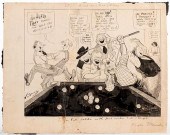 BRIGGS, CLARE (AMERICAN, 1875 Ð
BRIGGS, CLARE (AMERICAN, 1875 Ð 1930). MISSED ONE IN FR...Briggs, Clare (American, 1875 Ð 1930). Missed One in Front of the Pocket. Circa 1915. Pen and ink on paper. Inscribed and signed by the artist in the lower margin to Pat Valdo, performance director of Ringling Brothers Barnum & Bailey Circus. 16 _ x 13 _". Numerous creases, spotting, a few scrapes and losses.
BRIGGS, CLARE (AMERICAN, 1875 Ð
BRIGGS, CLARE (AMERICAN, 1875 Ð 1930). MISSED ONE IN FR...Briggs, Clare (American, 1875 Ð 1930). Missed One in Front of the Pocket. Circa 1915. Pen and ink on paper. Inscribed and signed by the artist in the lower margin to Pat Valdo, performance director of Ringling Brothers Barnum & Bailey Circus. 16 _ x 13 _". Numerous creases, spotting, a few scrapes and losses. -
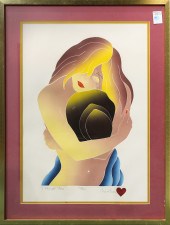 PRINT, MISHA Misha (American, b.
PRINT, MISHA Misha (American, b. 1944), "I Miss You," embossed relief print in colors, pencil signed lower right, titled lower left, edition 53/300, overall (with frame): 31.25"h x 24"w
PRINT, MISHA Misha (American, b.
PRINT, MISHA Misha (American, b. 1944), "I Miss You," embossed relief print in colors, pencil signed lower right, titled lower left, edition 53/300, overall (with frame): 31.25"h x 24"w -
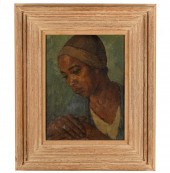 MISCHA (MAURICE) ASKENAZY (1888 -
MISCHA (MAURICE) ASKENAZY (1888 - 1961): PORTRAIT OF A WOMANoil on canvas; signed lower right 16 x 12 inches Condition:
MISCHA (MAURICE) ASKENAZY (1888 -
MISCHA (MAURICE) ASKENAZY (1888 - 1961): PORTRAIT OF A WOMANoil on canvas; signed lower right 16 x 12 inches Condition: -
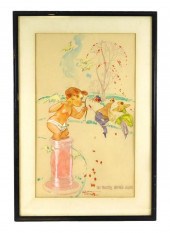 ILLUSTRATION: RUSSELL PATTERSON
ILLUSTRATION: RUSSELL PATTERSON (AMERICAN, 1896 - 1977), "OH SHUCKS, MISSED AGAIN", 1959, WATERCOLOR ON PAPER, DEPICTS CUPID STANDIN...ILLUSTRATION: Russell Patterson (American, 1896 - 1977), "Oh Shucks, Missed Again", 1959, watercolor on paper, depicts cupid standing on column in three-quarter profile view looking toward couple, arrow strikes the man's hind-quarters, tree in background with red leaves, and doves flying throughout, framed and matted under glass, signed LC, condition consistent with age including toning and light wear, ss: 24 1/4" h. x 14 3/4" w. [PROVENANCE: Artist was commissioned by consignor's mother to design a ten-piece series for the family's Janssens Restaurant in New York City in 1959 and subsequently passed down to the consignor. Commission fee per piece was $500 in 1959.]
ILLUSTRATION: RUSSELL PATTERSON
ILLUSTRATION: RUSSELL PATTERSON (AMERICAN, 1896 - 1977), "OH SHUCKS, MISSED AGAIN", 1959, WATERCOLOR ON PAPER, DEPICTS CUPID STANDIN...ILLUSTRATION: Russell Patterson (American, 1896 - 1977), "Oh Shucks, Missed Again", 1959, watercolor on paper, depicts cupid standing on column in three-quarter profile view looking toward couple, arrow strikes the man's hind-quarters, tree in background with red leaves, and doves flying throughout, framed and matted under glass, signed LC, condition consistent with age including toning and light wear, ss: 24 1/4" h. x 14 3/4" w. [PROVENANCE: Artist was commissioned by consignor's mother to design a ten-piece series for the family's Janssens Restaurant in New York City in 1959 and subsequently passed down to the consignor. Commission fee per piece was $500 in 1959.] -
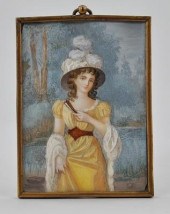 Unsigned miniature Painting of a
Unsigned miniature Painting of a Girl Holding a Fan The pretty miss in yellow stands in a forest landscape in front of a pond, framed in a narrow brass frame under glass overall approx. 4-1/8" x 3-1/8".
Unsigned miniature Painting of a
Unsigned miniature Painting of a Girl Holding a Fan The pretty miss in yellow stands in a forest landscape in front of a pond, framed in a narrow brass frame under glass overall approx. 4-1/8" x 3-1/8". -
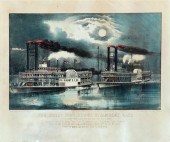 THE GREAT MISSISSIPPI STEAMBOAT
THE GREAT MISSISSIPPI STEAMBOAT RACE BY CURRIER & IVES. Handcolored lithograph on paper. Small folio C# 2630. Moonlit race between the steamboats Robt. E. Lee and Natchez. One of the New Best 50. Imperfections. Unframed 12''h. 14''w. Tears stains and restoration with some edge loss. Margins: T- 1 5/16'' B- 2 12/16'' L- 9/16'' R- 8/16''
THE GREAT MISSISSIPPI STEAMBOAT
THE GREAT MISSISSIPPI STEAMBOAT RACE BY CURRIER & IVES. Handcolored lithograph on paper. Small folio C# 2630. Moonlit race between the steamboats Robt. E. Lee and Natchez. One of the New Best 50. Imperfections. Unframed 12''h. 14''w. Tears stains and restoration with some edge loss. Margins: T- 1 5/16'' B- 2 12/16'' L- 9/16'' R- 8/16'' -
 MISS FRIDAYMiss Friday. Japan,
MISS FRIDAYMiss Friday. Japan, mid-twentieth century. Battery operated tin litho toy with some plastic components. Miss Friday works on her typewriter and has a fold out desk. 4 _ x 5 x 8î. Some hairs askew, soiling on arms and neck, hair tied with a piece of yarn. Not working. Good.
MISS FRIDAYMiss Friday. Japan,
MISS FRIDAYMiss Friday. Japan, mid-twentieth century. Battery operated tin litho toy with some plastic components. Miss Friday works on her typewriter and has a fold out desk. 4 _ x 5 x 8î. Some hairs askew, soiling on arms and neck, hair tied with a piece of yarn. Not working. Good. -
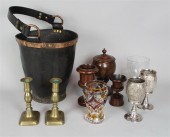 MISCELLANEOUS GROUP OF OBJECTS
MISCELLANEOUS GROUP OF OBJECTS including a leather fire bucket; a carved coconut on turned stand; two brass candlesticks; two small turned wood urns; a glass goblet engraved with a fox hunting scene; a Bohemian amber and ruby flashed wasted beaker; two Rogers Bros. plated goblets with repousse hummingbirds (10) - Provenance: Property of a gentleman
MISCELLANEOUS GROUP OF OBJECTS
MISCELLANEOUS GROUP OF OBJECTS including a leather fire bucket; a carved coconut on turned stand; two brass candlesticks; two small turned wood urns; a glass goblet engraved with a fox hunting scene; a Bohemian amber and ruby flashed wasted beaker; two Rogers Bros. plated goblets with repousse hummingbirds (10) - Provenance: Property of a gentleman -
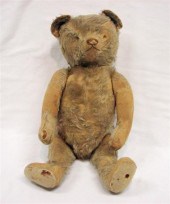 Mohair teddy bear 21'' l. missing
Mohair teddy bear 21'' l. missing eyes fur worn pads and nose.
Mohair teddy bear 21'' l. missing
Mohair teddy bear 21'' l. missing eyes fur worn pads and nose. -
 Cameo of the three graces not
Cameo of the three graces not mounted; cameo in mount woman's profile; carved Oriental hardstone pendant on chain; scarab and other stick pins cameo missing pin.
Cameo of the three graces not
Cameo of the three graces not mounted; cameo in mount woman's profile; carved Oriental hardstone pendant on chain; scarab and other stick pins cameo missing pin. -
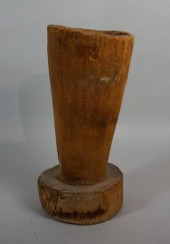 BASSWOOD MORTAR, MISSING
BASSWOOD MORTAR, MISSING PESTLEBASSWOOD MORTAR, MISSING PESTLE,
BASSWOOD MORTAR, MISSING
BASSWOOD MORTAR, MISSING PESTLEBASSWOOD MORTAR, MISSING PESTLE, -
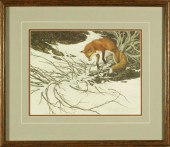 BEV DOOLITTLE OFFSET
BEV DOOLITTLE OFFSET LITHOGRAPHBEV DOOLITTLE (California, born 1947) offset lithograph, "Missed," fox and an arrow. Pencil signed lower right, edition 1448/3500, 9" x 12" (image), 16" x 18.75" (frame).
BEV DOOLITTLE OFFSET
BEV DOOLITTLE OFFSET LITHOGRAPHBEV DOOLITTLE (California, born 1947) offset lithograph, "Missed," fox and an arrow. Pencil signed lower right, edition 1448/3500, 9" x 12" (image), 16" x 18.75" (frame). -
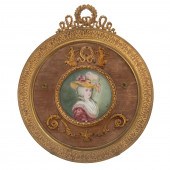 ENGLISH SCHOOL PORTRAIT MINIATURE
ENGLISH SCHOOL PORTRAIT MINIATURE MISS MILLS 18th century; gouache, portrait of beautiful young woman, identified on back as "Miss Mills," 2 1/4 in. Diam., in circular gilt metal frame.
ENGLISH SCHOOL PORTRAIT MINIATURE
ENGLISH SCHOOL PORTRAIT MINIATURE MISS MILLS 18th century; gouache, portrait of beautiful young woman, identified on back as "Miss Mills," 2 1/4 in. Diam., in circular gilt metal frame. -
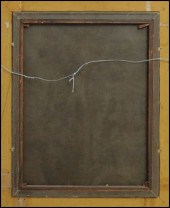 JAMES GALE TYLER (AMERICAN
JAMES GALE TYLER (AMERICAN 1855-1931) NEAR MISS IN MOONLIT SEA. Oil on canvas signed lower right 'James G. Tyler;' Frame: 37.75'' x 32.75'' 30'' x 25'' Condition: No Specific Condition Recorded - Sold As Is
JAMES GALE TYLER (AMERICAN
JAMES GALE TYLER (AMERICAN 1855-1931) NEAR MISS IN MOONLIT SEA. Oil on canvas signed lower right 'James G. Tyler;' Frame: 37.75'' x 32.75'' 30'' x 25'' Condition: No Specific Condition Recorded - Sold As Is -
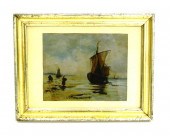 Unsigned oil on canvas beached
Unsigned oil on canvas beached sailboat with fisherwoman matted and framed behind glass some surface scratches and paint loss ss: 5 1/2'' h. x 9 1/2'' w.
Unsigned oil on canvas beached
Unsigned oil on canvas beached sailboat with fisherwoman matted and framed behind glass some surface scratches and paint loss ss: 5 1/2'' h. x 9 1/2'' w. -
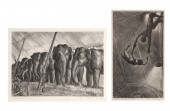 John Steuart Curry N.A.
John Steuart Curry N.A. (1897-1946 Madison WI) Two Works: ''The Missed Leap'' and ''Elephants''
John Steuart Curry N.A.
John Steuart Curry N.A. (1897-1946 Madison WI) Two Works: ''The Missed Leap'' and ''Elephants'' -
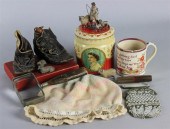 ODD GROUP OF OBJECTS including a
ODD GROUP OF OBJECTS including a pair of leather baby shoes; six lead animals and a lead shepherd; a crocheted baby hat; a small beaded bag; a boxed parlor game; a commemorative tin box; a lustre mug; a magnifying glass a small folding knife and another piece (16)
ODD GROUP OF OBJECTS including a
ODD GROUP OF OBJECTS including a pair of leather baby shoes; six lead animals and a lead shepherd; a crocheted baby hat; a small beaded bag; a boxed parlor game; a commemorative tin box; a lustre mug; a magnifying glass a small folding knife and another piece (16) -
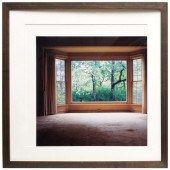 ALYSSA MISERENDINO, PHOTOGRAPH
ALYSSA MISERENDINO, PHOTOGRAPH Alyssa Miserendino (American, 20th/21st c.), Milwaukee, c. 2004, from the "Our World Insideout" project, photographic print, unsigned, 17.5"squ. (sight), 23.5"squ (frame)
ALYSSA MISERENDINO, PHOTOGRAPH
ALYSSA MISERENDINO, PHOTOGRAPH Alyssa Miserendino (American, 20th/21st c.), Milwaukee, c. 2004, from the "Our World Insideout" project, photographic print, unsigned, 17.5"squ. (sight), 23.5"squ (frame) -
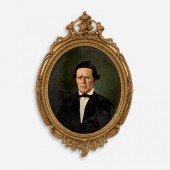 OIL PORTRAIT OF A GENTLEMAN,
OIL PORTRAIT OF A GENTLEMAN, MISSOURI 19TH C.An American oil of an unidentified gentleman, circa 3rd quarter 19th century and likely Missouri in origin given a James Spore St. Louis artist supply store stamp to the reverse. The oval canvas measures 30" x 25". Presented in an intricateframe that measures 48" x 33". Condition The condition is poor, given a substantial hole to the hair area and a network of tears to the forehead, bridge of the nose, and near one eye.
OIL PORTRAIT OF A GENTLEMAN,
OIL PORTRAIT OF A GENTLEMAN, MISSOURI 19TH C.An American oil of an unidentified gentleman, circa 3rd quarter 19th century and likely Missouri in origin given a James Spore St. Louis artist supply store stamp to the reverse. The oval canvas measures 30" x 25". Presented in an intricateframe that measures 48" x 33". Condition The condition is poor, given a substantial hole to the hair area and a network of tears to the forehead, bridge of the nose, and near one eye. -
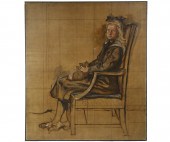 UNSIGNED MONUMENTAL BOSTON STUDIO
UNSIGNED MONUMENTAL BOSTON STUDIO PORTRAIT STUDY, CIRCA 1910 Gridded Study of a Young Girl with Her Cat in Her Lap, oil on canvas, unsigned, chiaroscuro on tan with some color to her face, she is dressed in a 'sailor's' outfit with a large bow in her hair, wearing 'sensible' shoes, turning to look at the viewer, in a modern black slat frame, OS: 48 1/2" x 42 1/2", SS: 48" x 42". One repaired puncture at her ear.
UNSIGNED MONUMENTAL BOSTON STUDIO
UNSIGNED MONUMENTAL BOSTON STUDIO PORTRAIT STUDY, CIRCA 1910 Gridded Study of a Young Girl with Her Cat in Her Lap, oil on canvas, unsigned, chiaroscuro on tan with some color to her face, she is dressed in a 'sailor's' outfit with a large bow in her hair, wearing 'sensible' shoes, turning to look at the viewer, in a modern black slat frame, OS: 48 1/2" x 42 1/2", SS: 48" x 42". One repaired puncture at her ear. -
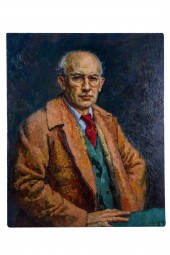 MISCHA (MAURICE) ASKENAZY
MISCHA (MAURICE) ASKENAZY (1888-1961): "PORTRAIT OF A GENTLEMAN"oil on canvas signed lower right unframed: 32 x 26 inches Condition:
MISCHA (MAURICE) ASKENAZY
MISCHA (MAURICE) ASKENAZY (1888-1961): "PORTRAIT OF A GENTLEMAN"oil on canvas signed lower right unframed: 32 x 26 inches Condition: -
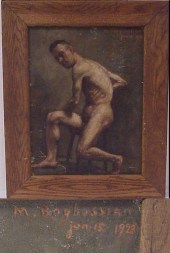 Missay Bogbossian (Turkish
Missay Bogbossian (Turkish 1884-1958) oil on board male nude signed upper right and dated June 15 1923 framed paint loss ss: 11 1/2'' h. x 8 3/4'' w.
Missay Bogbossian (Turkish
Missay Bogbossian (Turkish 1884-1958) oil on board male nude signed upper right and dated June 15 1923 framed paint loss ss: 11 1/2'' h. x 8 3/4'' w. -
 MINIATURE MEMORIAL LOCKET, CIRCA
MINIATURE MEMORIAL LOCKET, CIRCA 1815 A Young Man and Woman in Regency Dress stand either side of a tomb inscribed "Not lost but gone before", oil on ivory with a gold band at the top of the stone, in an oval gold locket with ring and remnants of added pin post on back, domed lens, 2" x 1 5/8", one area of loss at waist of man.
MINIATURE MEMORIAL LOCKET, CIRCA
MINIATURE MEMORIAL LOCKET, CIRCA 1815 A Young Man and Woman in Regency Dress stand either side of a tomb inscribed "Not lost but gone before", oil on ivory with a gold band at the top of the stone, in an oval gold locket with ring and remnants of added pin post on back, domed lens, 2" x 1 5/8", one area of loss at waist of man. -
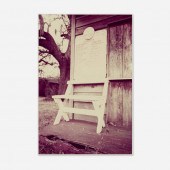 William Eggleston b.1939.
William Eggleston b.1939. Untitled (Missy's). C-print. 15 h × 10 w in. result: $645. estimate: $800–1,200. Signed to verso ‘W. Eggleston’.
William Eggleston b.1939.
William Eggleston b.1939. Untitled (Missy's). C-print. 15 h × 10 w in. result: $645. estimate: $800–1,200. Signed to verso ‘W. Eggleston’. -
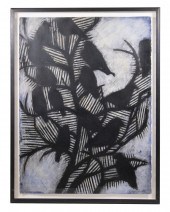 LISSA HUNTER (ME, 1945 - )
LISSA HUNTER (ME, 1945 - ) Untitled, mixed media, signed lower right, the deckle edge sheet suspended in a white interior shadowbox, under glass, with black exterior, OS: 33" x 25 1/2", SS: 30" x 22 1/2", good condition.
LISSA HUNTER (ME, 1945 - )
LISSA HUNTER (ME, 1945 - ) Untitled, mixed media, signed lower right, the deckle edge sheet suspended in a white interior shadowbox, under glass, with black exterior, OS: 33" x 25 1/2", SS: 30" x 22 1/2", good condition. -
 MESSA, Lou, (American, 20th C.):
MESSA, Lou, (American, 20th C.): Morning Mist, Watercolor, sight size 8 1/2'' x 19 1/2'', signed, framed, 18 1/2'' x 30''.
MESSA, Lou, (American, 20th C.):
MESSA, Lou, (American, 20th C.): Morning Mist, Watercolor, sight size 8 1/2'' x 19 1/2'', signed, framed, 18 1/2'' x 30''. -
 FRAME INK & WATERCOLOR POEMca. 1825
FRAME INK & WATERCOLOR POEMca. 1825 dated; two-part hand written poem letter to Miss Ei Bushar sent from "her friend J.S.", the poem about "you" blushing rose, "so beautiful but beware of secret thorn", framed in a bird's eye maple frame, 9 1/4"x 10 3/4" framed; Condition: appears removed composition box, no folds observed, some foxing
FRAME INK & WATERCOLOR POEMca. 1825
FRAME INK & WATERCOLOR POEMca. 1825 dated; two-part hand written poem letter to Miss Ei Bushar sent from "her friend J.S.", the poem about "you" blushing rose, "so beautiful but beware of secret thorn", framed in a bird's eye maple frame, 9 1/4"x 10 3/4" framed; Condition: appears removed composition box, no folds observed, some foxing -
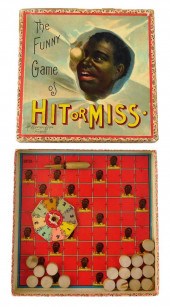 BLACK AMERICANA: BOARD GAME "THE
BLACK AMERICANA: BOARD GAME "THE FUNNY GAME OF HIT OR MISS", C. 1900, MCLOUGHLIN BROS., CONTAINS EIGHTEEN WOODEN DISC COUNTERS, ONE...BLACK AMERICANA: Board game "The Funny Game of Hit or Miss", c. 1900, McLoughlin Bros., contains eighteen wooden disc counters, one cardboard teetotem spinner with wood center, and a lithographed paper playing board applied to the bottom half of the box, box cover lithographed with an African-American boy''s head with a ball about to strike him, box cover inscribed, "The/ FUNNY/ Game/ of/ HIT OR MISS./ McLOUGHLIN BROS./ NEW YORK.", playing board chromolithographed with a path of squares, twenty-five of which repeat the box cover graphics, wear consistent with age and use, possibly missing piece(s), wear with surface loss to spinner and edges of box, etc., box: 7 1/2" sq. [NOTE: "Target games found in traveling carnival shows, seashore resorts, and fairgrounds throughout the nation stereotyped African-Americans as comical entertainers and provided a sanctioned outlet for white contempt of blacks. Players of Hit or Miss, inspired by target games, move along a gameboard checkered with blank spaces and African-American faces, calling out "hit" or "miss" depending on the spin of the teetotum." -New York Historical Society]
BLACK AMERICANA: BOARD GAME "THE
BLACK AMERICANA: BOARD GAME "THE FUNNY GAME OF HIT OR MISS", C. 1900, MCLOUGHLIN BROS., CONTAINS EIGHTEEN WOODEN DISC COUNTERS, ONE...BLACK AMERICANA: Board game "The Funny Game of Hit or Miss", c. 1900, McLoughlin Bros., contains eighteen wooden disc counters, one cardboard teetotem spinner with wood center, and a lithographed paper playing board applied to the bottom half of the box, box cover lithographed with an African-American boy''s head with a ball about to strike him, box cover inscribed, "The/ FUNNY/ Game/ of/ HIT OR MISS./ McLOUGHLIN BROS./ NEW YORK.", playing board chromolithographed with a path of squares, twenty-five of which repeat the box cover graphics, wear consistent with age and use, possibly missing piece(s), wear with surface loss to spinner and edges of box, etc., box: 7 1/2" sq. [NOTE: "Target games found in traveling carnival shows, seashore resorts, and fairgrounds throughout the nation stereotyped African-Americans as comical entertainers and provided a sanctioned outlet for white contempt of blacks. Players of Hit or Miss, inspired by target games, move along a gameboard checkered with blank spaces and African-American faces, calling out "hit" or "miss" depending on the spin of the teetotum." -New York Historical Society] -
 POSSOZ, Mily. Pencil Sketch of
POSSOZ, Mily. Pencil Sketch of Mother, Child, Cat c.1930 Signed lower left. Mily Possoz, French, 1888-1967. Size:16 x 14. Condition: Rough, unframed and unmatted, damp stains along left margin, one inch tear along left margin, various smaller losses and stains, bottom margin is an affixed strip of paper, probably by the artist.
POSSOZ, Mily. Pencil Sketch of
POSSOZ, Mily. Pencil Sketch of Mother, Child, Cat c.1930 Signed lower left. Mily Possoz, French, 1888-1967. Size:16 x 14. Condition: Rough, unframed and unmatted, damp stains along left margin, one inch tear along left margin, various smaller losses and stains, bottom margin is an affixed strip of paper, probably by the artist. -
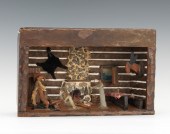 A Hand Made Folk Art Diorama
A Hand Made Folk Art Diorama Charmingly naive mixed materials shadow box containing a mother and child welcoming the hunter home with game in a log cabin interior with velvet bear skins moose trophy stone fireplace and furnishings all made from found materials at hand.
A Hand Made Folk Art Diorama
A Hand Made Folk Art Diorama Charmingly naive mixed materials shadow box containing a mother and child welcoming the hunter home with game in a log cabin interior with velvet bear skins moose trophy stone fireplace and furnishings all made from found materials at hand. -
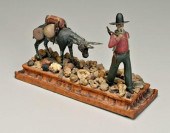 Carved prospector, mule, walking
Carved prospector, mule, walking through rocky area, mule staring at gold nugget tooth with crown prospector missed, prospector with pick, knife, pipe and revolver, origin unknown, probably 20th century, 9-1/2 x 14-1/2 x 5-1/2 in. Old painted surface with chips and losses, tail of mule repaired and possibly reattached, scattered glue residue, loss to top strap of mule's halter. Private Collection, Michigan
Carved prospector, mule, walking
Carved prospector, mule, walking through rocky area, mule staring at gold nugget tooth with crown prospector missed, prospector with pick, knife, pipe and revolver, origin unknown, probably 20th century, 9-1/2 x 14-1/2 x 5-1/2 in. Old painted surface with chips and losses, tail of mule repaired and possibly reattached, scattered glue residue, loss to top strap of mule's halter. Private Collection, Michigan -
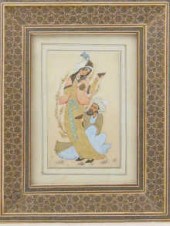 A framed and signed Persian
A framed and signed Persian miniature of a girl being courted by a man with gifts.
A framed and signed Persian
A framed and signed Persian miniature of a girl being courted by a man with gifts. -
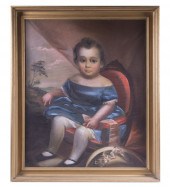 PORTRAIT BY LATE 19TH C.
PORTRAIT BY LATE 19TH C. ITINERANT MAINE ARTIST Little Girl in a blue silk dress, with huge doleful eyes, seated in a red chair in front of a posh draped landscape, her hat on the floor. Purported to be a child from a Wiscasset, ME family. In gold cove frame, OS: 34 1/2" x 29", SS: 29 1/2" x 24". Overall craquelure.
PORTRAIT BY LATE 19TH C.
PORTRAIT BY LATE 19TH C. ITINERANT MAINE ARTIST Little Girl in a blue silk dress, with huge doleful eyes, seated in a red chair in front of a posh draped landscape, her hat on the floor. Purported to be a child from a Wiscasset, ME family. In gold cove frame, OS: 34 1/2" x 29", SS: 29 1/2" x 24". Overall craquelure. -
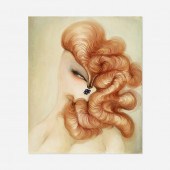 Miss Van. RedHair Muse. 2013,
Miss Van. RedHair Muse. 2013, acrylic on canvas. 24 h × 20 w in. result: $1,300. estimate: $1,500–2,500. Signed and dated to verso ‘Miss Van 2013’.
Miss Van. RedHair Muse. 2013,
Miss Van. RedHair Muse. 2013, acrylic on canvas. 24 h × 20 w in. result: $1,300. estimate: $1,500–2,500. Signed and dated to verso ‘Miss Van 2013’. -
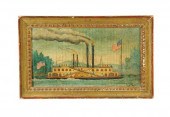 ***PORTRAIT OF LE MISSISSIPPI BY
***PORTRAIT OF LE MISSISSIPPI BY HECTRO TROTIN (FRANCE 1894-1966). Oil on board signed lower right and labeled on verso ''Le Mississippi Steam Boat des la a american 1832 Collection Sira No. 279.'' Portrait of the sidewheeler flying two US flags. Minor flake. 5''h. 9''w. in a period frame 6 1/4''h. 10 1/4''w. There is a large flake and many spots of touch-up. They are mostly in the sky area and water. None in the ship or flags.
***PORTRAIT OF LE MISSISSIPPI BY
***PORTRAIT OF LE MISSISSIPPI BY HECTRO TROTIN (FRANCE 1894-1966). Oil on board signed lower right and labeled on verso ''Le Mississippi Steam Boat des la a american 1832 Collection Sira No. 279.'' Portrait of the sidewheeler flying two US flags. Minor flake. 5''h. 9''w. in a period frame 6 1/4''h. 10 1/4''w. There is a large flake and many spots of touch-up. They are mostly in the sky area and water. None in the ship or flags. -
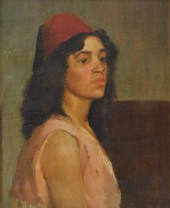 LATE 19TH/ EARLY 20TH C. OIL ON
LATE 19TH/ EARLY 20TH C. OIL ON CANVAS, PORTRAIT OF A YOUNG WOMAN, DARK EYES AND HAIR, PINK BLOUSE, AND RED FEZ HAT, UNSIGNED, GILT...Late 19th/ early 20th C. oil on canvas, portrait of a young woman, dark eyes and hair, pink blouse, and red fez hat, unsigned, gilt wood frame with some paint loss and scratches, illegible inscription verso, wear consistent with age including craquelure, small areas of flaked paint, not examined out of frame, ss: 21 1/2" h. x 17 1/2" w.
LATE 19TH/ EARLY 20TH C. OIL ON
LATE 19TH/ EARLY 20TH C. OIL ON CANVAS, PORTRAIT OF A YOUNG WOMAN, DARK EYES AND HAIR, PINK BLOUSE, AND RED FEZ HAT, UNSIGNED, GILT...Late 19th/ early 20th C. oil on canvas, portrait of a young woman, dark eyes and hair, pink blouse, and red fez hat, unsigned, gilt wood frame with some paint loss and scratches, illegible inscription verso, wear consistent with age including craquelure, small areas of flaked paint, not examined out of frame, ss: 21 1/2" h. x 17 1/2" w.
...many more examples with full details are available to our members - Learn more


